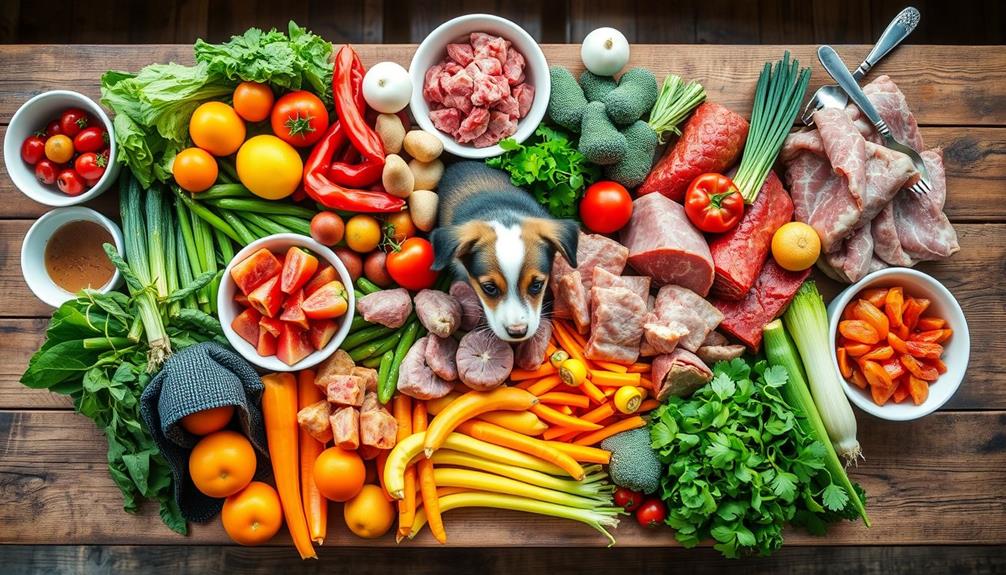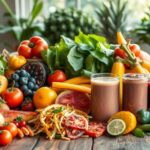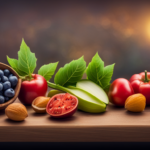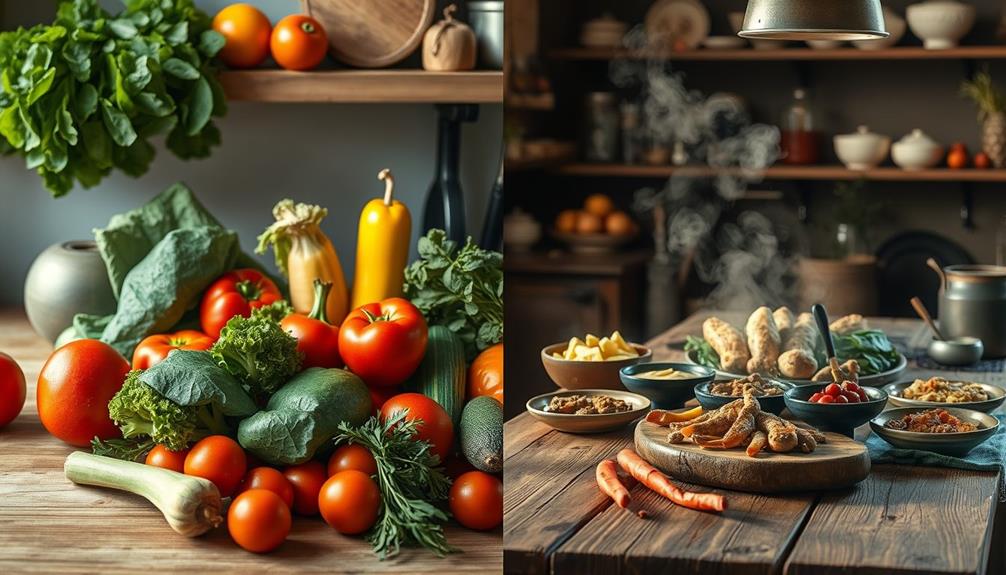Eating raw food can offer you a wealth of health benefits, like increased nutrient intake and improved digestive health. You'll enjoy higher energy levels and may find it easier to manage your weight. The fiber-rich, whole foods promote regularity and support skin health, giving you a clearer complexion. However, you need to be aware of potential risks, such as nutrient deficiencies in protein and vitamin B12, along with food safety concerns like bacterial contamination in raw products. If you're curious about how to enjoy raw foods safely, there's much more to explore on this exciting culinary journey.
Key Takeaways
- Raw foods are nutrient-dense, boosting vitamin and antioxidant intake, especially vitamin C and potassium.
- A raw food diet can enhance digestive health due to high fiber and water content.
- There are risks of nutrient deficiencies, including vitamin B12 and protein, which require careful planning.
- Consuming raw foods can improve energy levels and support weight management through lower caloric intake.
- Food safety is a major concern, as raw animal products and certain raw vegetables can harbor harmful pathogens.
Overview of Raw Food Diet
The raw food diet's appeal lies in its focus on unprocessed, whole foods that promise to maximize nutritional benefits. By emphasizing the consumption of fruits, vegetables, nuts, seeds, and sprouted grains, this diet aims to preserve essential nutrients and enzymes by avoiding any food heated above 104-118°F (40-48°C).
Cranberry juice consumption may further enhance health due to its antioxidant properties. Variations like raw vegan, raw vegetarian, and raw omnivorous cater to different preferences, providing dietary flexibility while adhering to the core principles of the raw food diet.
Preparation methods permitted in this diet include blending, juicing, dehydrating, soaking, and sprouting, enhancing the nutritional profile of your meals.
While many advocates tout health benefits such as weight loss and increased energy levels, it's vital to recognize the risk of nutrient deficiencies, particularly in protein and vitamin B12. To maintain a balanced intake, careful meal planning is necessary.
You'll need to contemplate food combinations and possibly supplementation to guarantee you're meeting your nutritional needs while enjoying the fresh, vibrant foods that the raw food diet promotes. Balancing enjoyment with health can lead to a rewarding experience as you explore this lifestyle.
Health Benefits

Eating raw foods can greatly boost your nutrient intake, thanks to their high levels of vitamins, minerals, and antioxidants. This nutrient density not only supports overall health but can also aid in weight loss, allowing you to shed unwanted pounds more easily.
Additionally, raw foods support digestive health with their high water content and fiber, further enhancing your well-being. By incorporating more raw fruits and vegetables into your diet, you may find yourself feeling more energized and essential, which is a common benefit of a raw food diet.
Nutrient Density Advantages
With a focus on nutrient density, raw food diets offer a wealth of essential vitamins and minerals that can greatly enhance your overall health. These diets are packed with significant nutrients like vitamin C and potassium, which support immune function and overall well-being.
Additionally, incorporating raw foods can be part of a broader strategy to select the right cold medication for those who may suffer from colds, as a strong immune system is essential during such times. The high fiber content found in raw foods aids digestion and promotes satiety, helping reduce the risk of chronic diseases such as heart disease and type 2 diabetes.
Moreover, consuming raw fruits and vegetables allows you to enjoy lower calorie intake while still feeling full, which is beneficial for your weight management goals. Raw food diets also retain natural enzymes that aid digestion and improve nutrient absorption, further enhancing the nutritional value of your meals.
As you incorporate more raw plant foods into your diet, you might notice improved skin health and increased energy levels. The hydrating and nutrient-rich nature of these foods contributes to a clearer complexion and greater energy, making raw food diets not only a healthful choice but an enjoyable one too.
Embracing the nutrient density advantages of raw foods can pave the way for a healthier lifestyle.
Weight Loss Support
Raw food diets not only enhance nutrient density but also offer robust support for weight loss. By focusing on fresh, unprocessed foods, you naturally reduce your calorie intake while still enjoying substantial meals. The high fiber content in fruits and vegetables keeps you feeling full, promoting satiety and helping to curb cravings for high-calorie processed foods.
Additionally, maintaining a balanced diet with safe snacks can contribute to overall health, as seen in safe snacks for hamsters, which emphasizes the importance of moderation and nutrient quality.
Here are three key benefits of a raw food diet for weight loss:
- Low Calorie Density: Raw foods are generally low in calories, allowing you to consume larger portions without exceeding your caloric goals.
- Enhanced Digestion: The fiber-rich nature of raw foods aids digestion, which can improve metabolic health and energy utilization, further supporting your weight loss efforts.
- Improved Nutrient Intake: By consuming nutrient-dense foods, you're less likely to experience nutrient deficiencies, reducing potential health risks associated with restrictive diets.
Incorporating a raw food diet into your lifestyle can lead to significant weight loss while promoting better health overall. Enjoy the benefits of cleaner eating, improved digestion, and a more efficient metabolism!
Nutritional Risks

A strict adherence to a raw food diet can create significant nutritional risks that may jeopardize your health. Following a raw vegan diet often leads to deficiencies in essential nutrients like vitamin B12, calcium, iron, and omega-3 fatty acids. These nutrients are vital for maintaining energy levels and overall bodily functions.
Without enough protein—less than 10% of your calories—it's easy to develop anemia, which can leave you feeling fatigued. Additionally, it's important to take into account financial implications of specialized diets, as the costs of organic and raw foods can add up over time.
Inadequate vitamin D and calcium intake from non-dairy sources can weaken your bones, increasing the risk of osteoporosis. Additionally, the high acidity from consuming large amounts of raw fruits can contribute to dental erosion if you don't maintain proper oral hygiene.
Nutritional imbalances may also result in menstrual irregularities, with studies showing that approximately 70% of women on raw vegan diets experience such issues.
It's essential to be mindful of these risks when weighing a raw food diet. While it may have its benefits, the potential for deficiencies and health complications shouldn't be overlooked. Balancing your diet and ensuring you meet all your nutritional needs is vital for your overall well-being.
Food Safety Concerns

When you choose to eat raw foods, you need to be aware of the potential risks, especially with raw animal products like meat and seafood, which can carry harmful pathogens.
Individuals with certain mental health conditions, such as Borderline Personality Disorder, may experience heightened emotional responses that could affect their food choices and safety practices.
Bacterial contamination is a serious concern, not just with animal products but also with certain raw vegetables like sprouts.
Additionally, some foods, such as kidney beans and cassava, must be cooked to eliminate toxic compounds, highlighting the importance of food safety practices.
Raw Animal Product Risks
One in six Americans gets sick from foodborne illnesses each year, and consuming raw animal products notably raises that risk. These products, including raw eggs, unpasteurized dairy, and undercooked meats, can harbor harmful bacteria like Salmonella and E. coli, leading to serious health complications.
Additionally, just as with mammography screening for early detection of diseases, proper food safety practices are vital to reducing health risks associated with food consumption, especially when it comes to raw items mammography aims to detect harmful pathogens.
To help you understand the risks, consider these three key points:
- Raw Eggs: They may contain Salmonella, especially dangerous for young children and those with weakened immune systems.
- Unpasteurized Dairy: This can harbor pathogens that pose severe risks, particularly for pregnant women and the elderly.
- Undercooked Meats: Eating raw or undercooked meats increases your risk of parasitic infections and bacterial illnesses, which can cause symptoms ranging from mild gastrointestinal distress to severe conditions.
Proper handling, storage, and sourcing of raw animal products are vital to mitigate the risks of contamination.
Ignoring these practices can greatly heighten your chances of encountering foodborne illnesses, so it's important to prioritize food safety when considering raw animal products in your diet.
Bacterial Contamination Issues
Bacterial contamination poses a serious threat to your health, especially when consuming raw foods. Harmful bacteria like Salmonella and E. coli can lurk in raw animal products, leading to severe foodborne illness. Sprouted foods may also carry contamination risks due to the warm, moist conditions that favor bacterial growth. The CDC estimates that 1 in 6 Americans get sick from foodborne illnesses each year, emphasizing the need for proper handling of raw foods.
To help you understand the risks better, here's a quick overview:
| Food Type | Contamination Risks |
|---|---|
| Raw Animal Products | Salmonella, E. coli |
| Sprouted Foods | Bacterial growth in moist conditions |
| Raw Vegetables | Pathogens from soil and water |
| Toxic Raw Foods | Cassava, kidney beans if not prepared |
To reduce the risk of bacterial contamination, guarantee you wash raw vegetables thoroughly and follow food safety practices. Being informed about these potential dangers can keep you safe while enjoying the benefits of raw food.
Toxic Raw Foods
Toxic raw foods can pose significant health risks if not properly prepared. Certain items in your diet might look appealing but can lead to severe health issues. For instance, raw kidney beans contain toxins that can cause nausea and vomiting if consumed without cooking.
Similarly, raw cassava has cyanogenic compounds that can release dangerous cyanide when not prepared correctly. Additionally, hygiene practices are vital in food preparation, much like piercing care essentials, to avoid harmful bacteria.
To help you stay safe, here are three toxic raw foods to be cautious about:
- Raw Sprouts: Alfalfa and clover sprouts can harbor harmful bacteria like E. coli and Salmonella, increasing your risk of foodborne illness.
- Raw Eggs: These may carry Salmonella bacteria, leading to gastrointestinal illness if consumed uncooked.
- Raw Fish: Consuming raw fish can expose you to parasites and pathogens, especially if not sourced from reputable suppliers.
Being mindful of food safety practices is essential when considering a raw food diet. Always verify proper preparation to avoid the potential dangers associated with these toxic raw foods.
Preparation Techniques

Preparing raw foods effectively can greatly enhance their nutritional benefits and digestion. One of the best preparation methods is soaking beans and grains in water, which helps improve digestion and reduces anti-nutrients. This makes them easier to digest when consumed raw or sprouted.
Additionally, incorporating unique planter designs can encourage you to grow your own sprouts and microgreens at home, providing fresh and nutritious additions to your raw meals. Sprouting seeds and grains not only enhances their nutrient profile but also increases the bioavailable nutrients, making vitamins and minerals more accessible to your body.
Another technique to evaluate is dehydrating fruits and vegetables at temperatures below 118°F. This method preserves their flavor and nutrients while extending shelf life.
Juicing fresh fruits and vegetables is an excellent way to achieve concentrated nutrient intake, allowing for quick absorption of essential vitamins and minerals.
Blending raw foods into smoothies can also help you incorporate a variety of fruits and vegetables into your diet. This process makes them easier to consume and digest, ensuring you're getting a diverse range of nutrients.
Sample Meal Plans

Incorporating raw foods into your daily routine can be both enjoyable and nutritionally beneficial when you have a well-structured meal plan.
For added health benefits, consider using essential oils, such as peppermint oil for digestive support, which can enhance the overall experience of your raw food diet.
Here's a sample meal plan to get you started on your raw food diet:
- Breakfast: Kickstart your day with a smoothie made from blended fruits and leafy greens. This nutrient-dense meal provides essential vitamins and minerals to energize you.
- Lunch: Enjoy a colorful salad filled with a variety of raw vegetables, nuts, and seeds. This dish is rich in fiber and healthy fats, making it a satisfying and nourishing option.
- Snack: For a quick energy boost, grab some raw energy balls made from dates, nuts, and seeds. They're perfect to keep you going without processed sugars.
- Dinner: Try zucchini noodles topped with a fresh raw tomato sauce. This low-calorie dish combines fresh produce for a light yet fulfilling meal.
- Dessert: End your day with chia pudding made from almond milk and topped with fresh berries. It's packed with antioxidants and healthy omega-3 fatty acids.
These sample meal plans will help you enjoy the benefits of a raw food diet while keeping your meals delicious and balanced!
Tips for Beginners

Starting a raw food diet can feel overwhelming, but you can ease the change by focusing on simple recipes. Begin with easy-to-make dishes like smoothies or salads that incorporate raw fruits and vegetables. Gradually increase your raw food intake to make the shift smoother.
To enhance meal variety and enjoyment, prioritize seasonal and local produce. These options not only taste better but also pack in more nutrients. Invest in essential kitchen tools like a high-quality blender or food processor, which are important for efficiently preparing diverse raw dishes.
Planning your meals is essential for balanced nutrition and avoiding food waste. Since the raw food diet can lead to deficiencies if not managed carefully, make sure you include a wide range of healthy foods in your diet.
Don't forget to connect with online communities or local groups. They're great for support, recipe sharing, and tips on handling the challenges of a raw food lifestyle. Engaging with others can help keep you motivated and inspired as you explore this exciting way of eating.
Frequently Asked Questions
What Are the Risks of Eating Raw Food?
Eating raw food can expose you to harmful bacteria and toxins, leading to foodborne illnesses. You might also face nutrient deficiencies and digestive discomfort, increasing your risk of osteoporosis and cardiovascular issues over time. On the other hand, eating raw food benefits include preserving more enzymes and nutrients that may be lost during cooking, leading to better digestion and absorption of essential vitamins and minerals. Additionally, raw fruits and vegetables can provide a rich source of fiber, antioxidants, and phytochemicals, which can promote overall health and reduce the risk of chronic diseases such as cancer and heart disease. Overall, while there are risks associated with eating raw food, when done properly and in moderation, it can offer several health benefits.
What Are the Benefits of Eating Raw Foods?
Imagine chowing down on vibrant veggies like they're the latest food trend. Eating raw foods boosts your vitamin intake, aids digestion, and might even help with weight loss, making you feel energized and revitalized.
What Are the Consequences of Eating Raw?
Eating raw can lead to nutrient deficiencies, digestive issues, and increased risk of foodborne illnesses. You might experience discomfort or health complications if you don't balance your diet and avoid certain toxic raw foods.
What Is the Disadvantage of Eating Raw Foods?
Did you know that about 60% of raw food dieters experience nutrient deficiencies? By skipping cooked foods, you risk missing essential vitamins and minerals, leading to fatigue and other health issues if you're not careful.
Conclusion
Embracing a raw food diet can offer numerous health benefits, but it's crucial to tread carefully. As the saying goes, "You are what you eat." By focusing on fresh, whole foods, you can nourish your body, but be mindful of the nutritional risks and food safety concerns that come with it. With proper preparation techniques and planning, you can enjoy vibrant meals that support your health. So, take the plunge, but do so with awareness and balance.

















